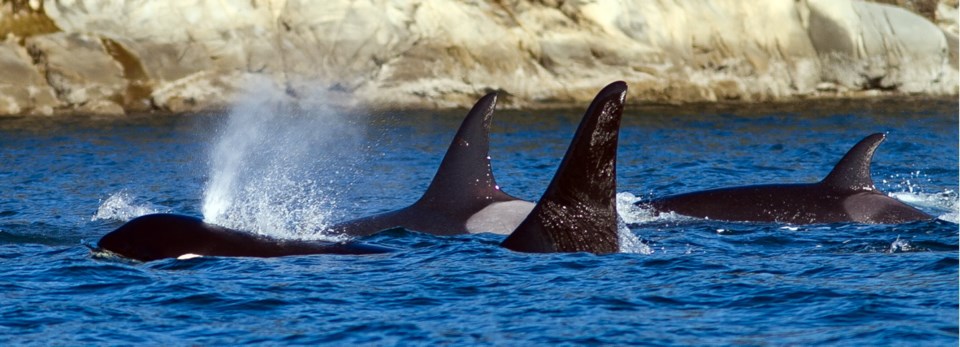A proposed clean-energy project may slow the speed of climate change, but it could also imperil threatened orcas, critics say.
Vancouver-based Weyl Power Ltd. — pronounced “wheel,” not “whale” — is eyeing two sites within the Northern resident killer whales’ critical habitat for ocean energy projects.
The company has only applied to monitor and investigate the potential of the sites, but a local orca researcher says it has already gone too far.
“It shouldn’t even get out of the starting gate — I don’t think the proposal should be considered at all, even at the investigative stage,” said Paul Spong, founder of the OrcaLab whale research station on Hanson Island, near Telegraph Cove.
Northern resident killer whales are classified as threatened under the species at risk act, which means they will likely become endangered if nothing is done. A critical habitat, as defined by the act, is necessary for the survival or recovery of a listed species.
The sites under consideration are an 881-hectare area in the Johnstone Strait between Hanson Island and Telegraph Cove, and a 953-hectare area in the Broughton Strait, near the western end of Malcolm Island.
Although some other tidal and wave energy companies have reported zero impact on marine species, Spong said the potential for noise pollution to interfere with the orcas’ communication is concerning.
“Everything should be done to improve the quality of life for the orcas. And when you introduce things like tidal power or tidal turbines, you’re actually introducing a new element to the environment that is potentially harmful to them.”
Weyl Power project manager Tony Irwin said the company has not determined if the sites are appropriate, or even what technology might be used. But he said it is committed to meeting environmental regulations, as well as consulting stakeholders such as local First Nations.
Weyl Power has only applied to conduct an acoustic survey, which he said won’t interfere with wildlife.
“It maps the sea floor using acoustic beams,” said Irwin. “Then we have an idea of whether there’s a resource there and, if so, where a likely place [for infrastructure] would be.”
News of the overlap with critical habitat isn’t enough reason to withdraw its investigative application, he said.
“We see no reason why we wouldn’t do the investigation. Everyone will have a second chance to look at a proposal, which would be very far down the line,” Irwin said.
Beyond ignoring critical habitat, others criticized the application process. The Ministry of Forests, Lands and Natural Resource Operations opened Weyl Power’s investigative application for public comment, but included no mention of critical habitat or potential technologies.
“My concern is not with tidal power itself, but with the lack of necessary information included in the application to make any informed decision,” said Andrew Jones, owner of Port McNeill-based Kingfisher Wilderness Adventures.
“The application really contains no information other than a map.”
Ministry spokesman Greig Bethel said if Weyl’s application is approved, the next step will see the province screen the application for compatibility with provincial policy and weigh it against input from technical experts, referral agencies, First Nations and the public.
Weyl Power will be required to submit more thorough impact studies if the application advances.
“It’s important to note that the activities proposed in this application are investigative in nature, meaning the proponent will be conducting studies such as heritage and archaeological inquiries, habitat assessments, fish and wildlife impact assessments and engineering research to determine whether it is feasible for them to pursue this further,” Bethel said.
Weyl Power won’t be the first tidal power company to function in a whale habitat, if the project comes to fruition.
Ocean Renewable Power Company has operated power projects off Alaska and Maine, including in areas frequented by common minke whales and Atlantic salmon.
The fish are listed as endangered by the National Oceanic and Atmospheric Administration in the United States.
The company files annual reports monitoring the impact of the turbines on marine species, but has reported no instances of a fish or marine mammal being injured by the turbines. The monitoring is conducted in partnership with third-party researchers at the University of Maine, president and CEO Chris Sauer said.
“There’s never been one known fish or marine-mammal impact,” Sauer said.
Measuring noise pollution is more difficult, since NOAA guidelines aren’t optimized for high-current environments.
But the company came up with its own solution: a corded microphone that drifts with the current, to reduce interference, he said.
“It turns out, the noise that’s emitted is kind of lost, so there’s less ambient noise, which is good news,” he said.
Harnessing the power of the sea
Various technologies may be used to harness wave and tidal energy, including turbines similar to windmills.
Turbines could harm fish and marine mammals, the B.C. Sustainable Energy Association says on its website, but carefully placed screens could also lead them out of harm’s way.
“The greatest advantage of tidal current energy is that it is completely predictable, free and sustainable,” the association says.
The annual mean wave power offshore of Canada’s Pacific coast totals roughly 37,000 megawatts, which is equivalent to more than 55 per cent of Canadian electricity consumption, according to Fisheries and Oceans Canada.
There’s potential for an additional 19,000 megawatts along the Vancouver Island and Haida Gwaii shorelines, the B.C. energy ministry says, and 4,014 megawatts in tidal current energy potential.


